Prophecy (1979)
Directed by: John Frankenheimer
Written by: David Seltzer
Starring: Armand Assante, Richard Dysart, Robert Foxworth, Talia Shire
USA
AVAILABLE ON BLU-RAY: 16TH AUGUST, from EUREKA ENTERTAINMENT
RUNNING TIME: 104 mins
REVIEWED BY: Dr Lenera
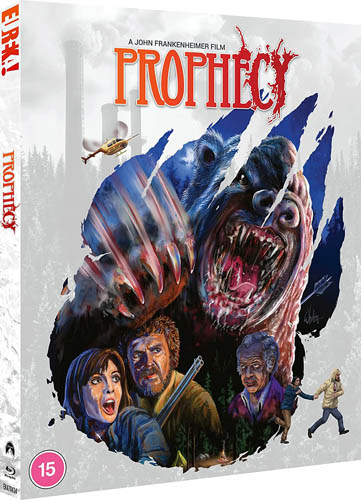
While searching for lost lumberjacks, three members of a search-and-rescue team are killed by an unseen force. A social worker trying to make a difference against impossible odds in the inner city, Dr. Robert Verne is offered a job to visit a Maine river community, where the Native American population, led by John, is trying to disrupt the logging company they claim is disrupting their homeland. However, the paper mill director blames the Native Americans for the missing people, while the natives themselves believe that the culprit is Katahdin, a vengeful spirit of the forest that has been awakened by the activities of the loggers. Verne brings wife Maggie with him into this tense situation, although she’s struggling with news of a pregnancy which she doesn’t want to divulge to Verne who she knows won’t take the news kindly. Then Verne discovers evidence of mutation in some of the local flora and fauna….
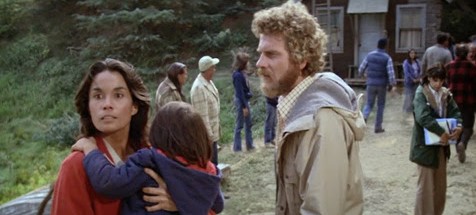
Our friends at Eureka Entertainmenthave released several of John Frankenheimer’s films in the past, though I doubted that they’d ever get to Prophecy, which comes from a distinctly less successful period in his career than the likes of The Manchurian Candidate, The Birdman Of Alcatraz and Seconds, and is a film regarded by many as a low point for him. Us monster movie lovers tend not to look down on such films though, and at one point I almost ordered the North American Scream Factory release so I could see it again and maybe review it. One shouldn’t forget that Frankenheimer dabbled in not entirely different waters later with The Island Of Dr. Moreau, and didn’t make that bad a job of it despite that film being generally known as the one where Richard Stanley was kicked off and had his screenplay heavily rewritten. Prophecy is one of the more ambitious entries in the cycle of monster movies made in the ’70s and early ’80s where deadly creatures were born of environmental pollution and human tampering with nature. Frankenheimer feels that it should have been better, blaming the fact that he had a serious drinking problem at the time he was making it, but its melding of ecological, sociological and horror themes works quite well even though it has a habit of introducing plot elements which it then can’t really contain – perhaps it should have been longer – and which therefore disappear. It’s not a full-on monster fest, instead telling its story at a deliberate pace until the action-filled final third in the manner of most similar films of the period, but does it well enough. I hope that Frankenheimer wasn’t too ashamed of it because he needn’t have been – and, despite what you may have heard, it features a reasonable monster.
Screenwriter David Seltzer was inspired by an environmental disaster in 1958 in the Japanese city of Minimata, where mercury waste dumped into a nearby river from a chemical plant caused severe mutations and neurological degenerations among the locals. The effects of this consisted of loss of muscular control, vision and hearing, followed by insanity and paralysis. The original concept for Katahdin was close to the original poster art, but Frankenheimer wanted a more believable bear-like animal. Inside the suit were Tom McLoughlin and Kevin Peter Hall who went on to play other man-in-a-suit monsters in the likes of Predator and Harry and the Hendersons. Though predominantly set in the woods of the state of Maine the film was shot with Crofton, North Cowichan in British Columbia, Canada portraying the region, the film marking the beginning of “Hollywood North”, the major start to the development of a massive film production business in Vancouver and other areas within the province. The crew lost a stunt driver and even narrowly escaped losing a cast member or two when their first construction truck [the 4wd monster one our ensemble try to escape in) took a dive off a cliff. They had to scramble to find another one. Some violence/gore and other scenes were deleted because the studio decided they wanted a ‘PG-rated film. These included a longer close-up of a headless corpse, some disemboweling, a flashback to a sex scene, and extensions of several scenes, including a longer tour of the paper mill. UK cinema and video versions received 8 secs of mandatory cuts by the BBFC to remove shots of a raccoon writhing on the floor – the animal had been genuinely poisoned. These edits remain in the Blu-ray version. Prophecy wasn’t the flop it’s often said to be; it made money but not much.
The beginning truly is great, though it perhaps sets up expectations that it’s going to contain a lot of visual invention. After the titles appear against a black background while we hear the sound of a fierce wind, said background remains while we see first a flashing light in the middle of the screen followed by two others, which then disappear to be quickly followed by six lights coming from the left of the still-black screen. As they move and get closer, we can see parts of trees briefly lit up by the lights, which are obviously torches, while the sound of panting dogs is heard. As things get a bit lighter – in fact they get far too light seeing as we’re firstly in the dead of night and then suddenly switch to early day time though I was so caught up in the scene that I’ve only realised it now as I type – the dogs rush ahead, clearly smelling something, and drag the men to the edge of a cliff. One breaks free and falls to its death, the others nearly pull the men over the edge. Two lower themselves to the bottom and are killed by something, the remaining team member falls onto a rock and comes to just in time to scream at something about to get him, the camera then cutting to the bloody carnage while rather calming classical music plays, which seems to be a strange device; we eventually cut to a concert hall but the previous scene would have been more horrific if the music had come in later. Maggie Verne is a cellist and rehearsing for a concert; however, the most important thing on her mind is her pregnancy. It would seemingly get in the way of the work of her husband, seen entering a rough-looking ghetto to take a sick baby to a hospital, but telling his boss of the futility of his work. Never mind, his boss has another job for him, one where he could certainly make a difference by filing a report, though what side will he take?
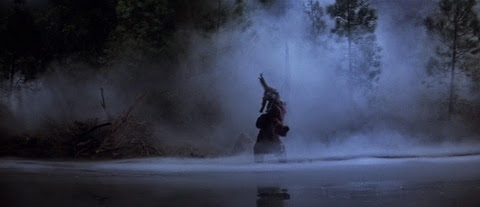
After seeing a dog – the sole survivor of the massacre we haven’t long seen – on a helicopter air lift, our couple are welcomed by Bethel Isely the local paper mill director, who tells him that the troublesome local Indians, nicknamed the Opies though we disappointingly never learn the name of this tribe [and I’m not sure that Native Americans in this locale lived in tipis either], have blocked all the roads around the forest because timber cutting is destroying their land. Indeed there’s soon a confrontation when Isley’s car transporting the Vernes plus another one following come up against a barrier and a group of Opies. Opie John Hawks won’t budge, so Isley’s bodyguard, Kelso goes to chainsaw a tree causing Hawk and he to fight. By now it does seem that the script is presenting as many liberal causes as it can cram in, but we soon take the side of the Opies as the Vernes are shown their way of life, awakening them to what they’re really like as opposed to the trouble making drunks they’re known us [though even if some are still trouble making drunks then it’s entirely understandable why]. I love films where protagonists are shown another side to a situation, have their minds opened by spending time with a different culture which may not necessarily be superior [though the Native Americans are much closer to the planet] but which can teach them things. This means that I’d have liked it if we had more time with the Opies, but we have to get on with the plot. An oversized salmon, a violent raccoon and plants growing on the surface are among the strange sights that Robert sees. Could this mill have something to do with it? There’s much time spent on Robert playing detective, even touring the mill, before a group sent to arrest Hawk and his friends, the Vernes and a camping family all converge on the forest where Katahdin is around.
So let’s do some defending. Katahdin has been mocked for looking very poor, and there’s no doubt that, when eventually seen in the final third, the sight of this bear-like animal is a disappointment after we’ve heard talk of something containing “a part of all things created”. Seltzer left the production when he saw it. Showing generally the top half was probably wise because it seems like this monster moves via a mechanical dolly and hydraulic levers; we don’t see the apparatus but it’s pretty obvious in certainly one sequence. And it appears to change size quite dramatically; even if Frankenheimer wasn’t properly focused, surely the special effects and photography units ought to have picked up on this before it was too late? We’re told that Rick Baker wanted too much time and Stan Winston wanted too much money to create the creature. But the costume is reasonably detailed and the visage appropriately hideous. I try to judge special effects by the standards of the times they were created in, and I don’t think that, even for 1979, this creature is that bad. He has a habit of suddenly attacking out of the blue and viciously too, though it’s very obvious where one messy kill has been truncated. We do though get a shocking if bloodless sleeping bag kill, and it’s surprising that, even if one takes into account that the ‘PG’ rating was much more lenient back then, the American rating it got is still surprising. Then there are baby creatures which are clearly hand puppets but look so ugly that we feel a very strong combination of repulsion and pity.
By this stage Frankenheimer had abandoned the strong styling of his early films with their deep focus, odd angles, POV shots and that favourite device of having the head of a character really close to the screen with others in the background on the other side. Still, cinematographer Harry Stradling Jr. is allowed to dwell on the wonder of the forest, there’s a nice shot when fire is reflected in someone’s eyes who’s wearing glasses, and we get a very upsetting cut from this almost-too-gorgeous-to-be-true lake to the other side of the same lake where this saw mill resides, ugly and the area both in and out of the water full of what are ugly, contaminating sights compared to what we’ve just seen. We rightfully feel angry at Isely and lines such as, “transports are handled by a private contractor”, “that’s why they use it, it’s cheap”, and “I supply what you demand”, yet the villainy isn’t overdone. Hawk is played by Armand Assante who would play several ethnic types though doesn’t look convincing at all as a Native American; his acting is okay but his character, as indeed everyone’s including our hero played okay by Robert Farnsworth, is thin. Of course Talia Shire is the standout, and it seems as if she’s going to be given some intense material to play regarding the impeding birth of her baby, but this subplot instead becomes the standout of the concerns that disappear with no resolving. Still, the moment when she finally tells the news to her husband is good; it happens at an inconvenient time but feels natural due to Shire’s acting. Leonard Rosenman’s quite astringent music doesn’t contain any memorable material but does increase the tension and is more absent than was the norm back then for monster movies. But then Prophecy tries to be a bit more. It doesn’t entirely succeed, but will hopefully still wind you up in the right way while you’re also getting your monster thrills.
Rating: 









SPECIAL FEATURES
Limited Edition O-Card slipcase featuring new artwork by Darren Wheeling [2000 copies]
1080p presentation on Blu-ray from a High Definition transfer
Eureka have probably used the master prepared by Scream Factory for their North American release but given it a new encode. With vibrant colour and even grain levels, it’s a fine restoration, though obviously helped by no rear projection being used, something which High Definition tends to unfortunately highlight.
Optional English SDH Subtitles
New feature length audio commentary by Richard Harland Smith
Eureka have dispersed with the six interviews on the Scream Factory, but have replaced them with two interviews of their own and two audio commentaries. Seems fair. The first track is a sober, laidback one with lots of gaps, but Harland Smith is still good to spend time with as he tells us how hugely secretive the project was to avoid a copycat film beating it to the box office [which is what happened with Frankenheimer’s previous film Black Sunday], that Canadian accountants on the production were skimming the budget and feeding the money into homegrown productions, and about the real events that inspired it [apparently the Minimata incident wasn’t the only one]. We also get the reason for why the two Katahdins are so different in size. Too much time spent on credits for the performers holds this track back, but it’s a solid affair.
New feature length audio commentary by film writers Lee Gambin & Emma Westwood
And here we get a very different track that focuses more on the film’s many themes. Opening with Westwood, who sounds distant, paying tribute to all indigenous people who’ve had their land colonised may be a bit too much for a commentary about a movie, but a lot of food for thought is provided here, while they think the characters are deeper than I did along with showing some love for the monster and the way that the film tries to be two things rather than one. The only real repetition from the previous track is some detail about the real-life inspirations and quotes from some reviews of the time which are always interesting to hear.
Truth in Fiction – New interview with screenwriter David Seltzer [13 mins]
The screenwriter, probably best known for The Omen which also started a trend for novelisations, talks of how his first scripting job was for Charlie And The Chocolate Factory because Roald Dahl hadn’t turned in his script; he had to be uncredited but in return he could have his next screenplay filmed. He also tells of how spending much time with a Native American while holidaying in a log cabin informed much of Prophecy, and how he likes to write in cramped spaces because his dreams are bigger. He doesn’t go that much into the monster or even mention that he walked.
Katadhin Speaks – New interview with mime artist Tom McLoughlin [19 mins]
McLoughlin talks of the early part of his very varied career, even telling of how, at age 7, he snuck onto the MGM backlot and stole a ‘Director’s Chair’ belonging to no less than John Sturges. We learn that the intention was to shoot all of Prophecy in Vancouver but it wasn’t working out so they did nearly all of the monster stuff in the studio, that Frankenheimer was “intimidating” but used his idea for having one monster victim crawl under a fence instead of over it despite telling him off for suggesting something to him in public, and hear Frankenheimer’s response to being asked by McLoughlin what his passion was in terms of directing – which certainly wasn’t directing. McLoughlin always seems likable and energetic in interviews.
Original Theatrical Trailer
TV Spot
Radio Spots
Stills Galleries
A LIMITED EDITION collector’s booklet featuring new writing by Craig Ian Mann and an archival interview [2000 copies]
An often interesting slice of ecological horror, ‘Prophecy’ deserves praise for its [not fully realised] ambitions and is no way a disaster despite what some of Frankenheimer’s more snobby fans might say. Recommended.


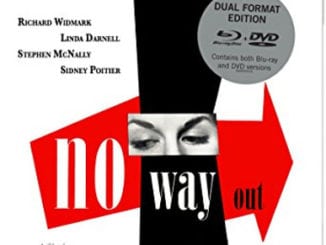
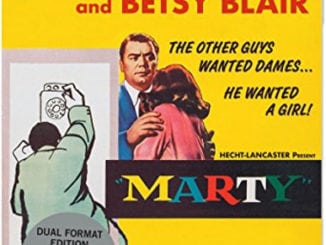
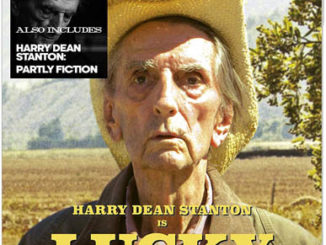
what differs from this transfer prophecy than the shout factory version is it worth buying I got the shot factory version but I don’t want to buy this find out it’s not worth buying what’s the difference
I don’t own the Shout Factory release, and my bible in these matters DVD Beaver hasn’t done their usual picture comparison between the two. However, Eureka have most likely used to the same transfer and just given it a new encode, meaning that the differences are very minor, such as a very slightly lighter or darker picture. Special features are all different though.